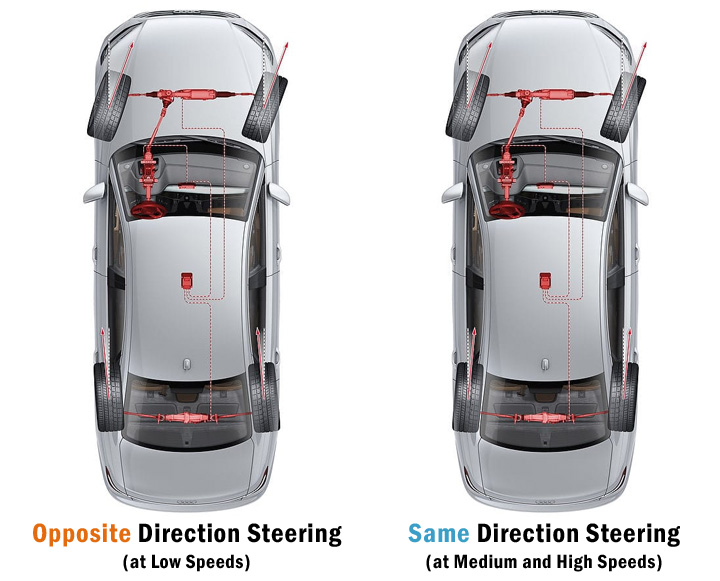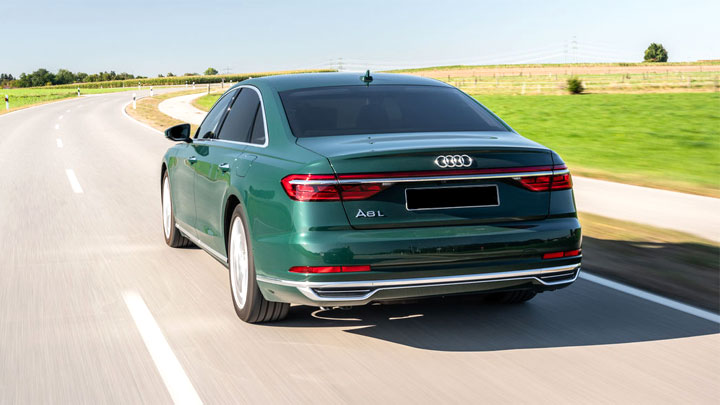29 Cars With Four-Wheel Steering (How It Works and Pros/Cons)
Four-wheel steering (4WS) adds agility and stability, but this promising tech hasn’t found widespread adoption – yet. From 1893 origins to 1980s Honda, discover the history of 4WS and how it’s making a small comeback.
Porsche, BMW and other luxury and sport car automakers deploy the latest systems. Learn how this technology works, its pros and cons, and which cars use four-wheel steering.

Read Also: Speed Sensing Steering (Why You’d Want It)
What is Four-Wheel Steering?
In essence, four-wheel steering (or all-wheel steering) means that all four wheels are utilized for steering instead of the typical front two wheels on a car. This helps improve stability at high speeds and allows for a tighter turn radius at low speeds (with less effort).
Obviously, you can’t have all four wheels turn in the same direction at the same angle at any speed. That would result in disaster. So instead, this system is heavily dependent on vehicle speed.
At low speeds (under 35 MPH or so), the rear wheels turn in the opposite direction as the front wheels. This is referred to as “counter-phase” steering and allows the vehicle to take tighter turns than if only the wheels on the front axle were turning. This is a big help in situations like U-turns and parallel parking, especially for longer vehicles.
At higher speeds, the rear wheels turn slightly in the same direction as the front wheels. This is referred to as “in-phase” steering. The benefit is that the vehicle feels more stable, especially when changing lanes or going through high speed corners (whether on the highway or track).

Is 4WS Always On?
Four-wheel steering isn’t always on since it can be designed as an active or passive system, depending on the car model. So, you might find that some vehicles enable it continuously, while others activate it only under specific situations.
In an active four-wheel steering system, the rear wheels turn along with the front wheels, improving your car’s maneuverability and handling. The rear wheels may turn in the opposite direction during low-speed maneuvers like parking, enabling you to easily fit into tight spots.
Once certain conditions are met (ie: a specific vehicle speed), the rear wheels will turn in the same direction as the front ones, providing better lane-changing stability and cornering.
On the other hand, a passive four-wheel steering system might only kick in when it detects particular driving conditions or at specific speeds. In such cases, the four-wheel steering will only be enabled when it’s most beneficial for your driving experience.
As the driver, you might not always notice when your four-wheel steering is activated if the system is working as it should. Just keep in mind vehicles with 4WS do not all have the same default behavior, so check with the vehicle manufacturer if you are curious about the specifics.
Advantages of Four-Wheel Steering

#1 – Better Steering Response
Your vehicle will respond faster to the steering that you perform overall. This allows your steering to be more precise and controllable on the road.
#2 – Cornering Stability
When you’re going around a corner in a vehicle, four-wheel steering will give you control and stability as you drive. This especially comes in handy if the road is wet.
#3 – Smaller Turning Radius
Because you can turn the rear wheels in the opposite direction of the front wheels, this allows you to make smaller circular turns at lower speeds.
#4 – Better on Tougher Terrains
If you live in an area with a lot of dirt roads or possibly snowy roads in the winter, then you’ll want a vehicle with four-wheel steering to help you drive better on these difficult terrains.
#5 – Straight Line Stability
If you’re driving your vehicle down a straight road, the four-wheel steering will give you the best stability you could ever want. This helps when you have potholes and high winds within the environment.
#6 – Easy Lane Changing
If you’re traveling fast on the interstate and you need to change lanes quickly, you can easily do so with a four-wheel steering vehicle without having to turn the steering wheel too much.
Disadvantages of Four-Wheel Steering
#1 – Expensive
As great as four-wheel steering systems are, they also require many more components in their construction than two-wheel steering systems. Because of this, vehicles with four-wheel steering are more expensive.
#2 – Bigger Chance of Problems
Due to the fact that four-wheel steering systems have many components, especially electronic components, the entire system could become inoperable if just one of these components malfunctions.
This means you’ll spend more time repairing or replacing components in a four-wheel steering system vehicle.
Vehicles With 4-Wheel Steering

Here are some of the more notable models that have had some variation of all-wheel steering in their history. There are many others.
See Also: Top 19 Sports Cars Under $50,000
- Honda Prelude
- Acura RLX
- Acura TLX
- Nissan 300 ZX
- Nissan Skyline R34 GT-R
- Lamborghini Aventador S
- Lamborghini Urus
- Porsche 911
- Porsche Cayenne
- Porsche Panamera
- Ferrari 812 Superfast
- Mitsubishi 3000GT
- Mitsubishi Galant VR-4
- Renault Megane RS
- Audi A6
- Audi A7
- Audi A8
- BMW 5 Series
- BMW 7 Series
- BMW 850 CSi
- Mercedes AMG GT R
- Lexus GS
- Lexus LC 500
- Lexus LS 500
- Lexus RC
- Cadillac CT6
- Ford F-150 Platinum ZF
- Chevy Silverado
- GMC Sierra 1500 Denali
Manufacturer Specific 4WS System Names
- Acura – P-AWS (Precision All-Wheel Steer)
- Audi – Dynamic All-Wheel Steering
- Bentley – Rear-Axle Steering
- BMW – Integral Active Steering
- Cadillac – Active Rear Steering
- Ferrari – Virtual Short Wheelbase
- Genesis – Genesis Rear-Wheel Steering
- GMC – QuadraSteer (features CrabWalk setting)
- Honda – Steer-Angle Dependent 4-Wheel Steering System
- Lamborghini – Lamborghini Rear-wheel Steering
- Lexus – Dynamic Rear-Wheel Steering
- Mercedes-Benz – Rear-Axle Steering
- Mitsubishi – AWC (All Wheel Control)
- Nissan – HICAS (High Capacity Active Steering)
- Porsche – Rear-Axle Steering
- Renault – 4Control
- Rolls-Royce – Rear-Axle Steering
Why Don’t More Vehicles Have Four-Wheel Steering?
You may be wondering why more cars and trucks don’t have four-wheel steering, considering its advantages. There are a few reasons for its limited adoption in the automotive market.
First of all, cost plays a significant role. Four-wheel steering systems are more complex and expensive to develop, produce, and maintain. Manufacturers often have to weigh the benefits against the added cost to both them and the consumer. For many vehicles, particularly lower-priced models, implementing 4WS is simply not be worth the extra expense.
Consumer demand is another factor. Most drivers are accustomed to and comfortable with traditional front-wheel steering. Four-wheel steering might seem unfamiliar, and some drivers may not readily see the benefits – especially if they have never experienced it themselves. Manufacturers are therefore less likely to invest in technology that may not have widespread appeal.
Finally, vehicle design can be a limiting factor. 4WS requires additional components and space, potentially altering a vehicle’s design. Some vehicles may not have the necessary room to accommodate the system, or designers may be unwilling to sacrifice aesthetics or other features to implement four-wheel steering.
4WS vs 4WD
While the abbreviations may be similar and both try to improve the driving experience, these systems are completely different.
4WS (four-wheel steering) allows your car to have better steering response and cornering stability. At lower speeds, the rear wheels turn opposite the front wheels, creating a tighter turning radius. At higher speeds, all four wheels turn in the same direction to improve stability.
On the other hand, 4WD (four-wheel drive) focuses on maximizing traction for off-road or slippery conditions. It distributes power to all four wheels, keeping your vehicle’s grip steady in rough terrain.
See Also: 4WD vs AWD (What’s the Difference?)
- Replace the Engine or Replace the Car? (11 Factors to Consider) - Apr 11, 2024
- Plastic Piece Dragging Under Your Car? (What It Is and What To Do) - Mar 21, 2024
- Timing Belt vs Timing Chain (What’s the Difference?) - Feb 27, 2024

I’m no expert but the Honda Prelude system (wondering if that’s one of few or the only) was all mechanical, no computers or motors. I would be OK with that, I have driven them, and they bring new meaning to the words “lane change”!
does anyone make a kit for this to add on to cars
I own a 93 Honda prelude with 4 wheel steering. It is the best handling car I have ever driven. Once I added a 2k suspension system it brought it to another level. The car is simply a dream. More sports cars should come with it. I will never sell the car simply amazing!
There are a couple cars missing from this list like the 90’s Infiniti J30 and the 2011 to 2013 Infiniti M37s
No that steering system was not available for sale. The first sold car was the 1988 Honda prelude. I sold it. And drove it. !!!
the first car to have the all wheel steering system was the nissan passage gt 1986
This old guy had never heard of that car, and being in the car business, and a serious racer, I was curious because I was sure the Honda Prelude was first. Looks like that Passage, with RH drive, wouldn’t have been sold in the US.
Bmw 840d, bmw m850 and bmw m8 all have 4 wheel steering since 2018
In my 90 years of living, I’ve learned that nothing invented or built by man is infallible. What if at 60 or 70 mph, the rear wheels decide to steer on their own into another Lane? Wouldn’t that spell disaster if you hit another car? No thanks I’ll stick to the old steering system.
It’s true that with more components comes more complexity. However, these systems are rigorously tested by engineers before they are productionalized. The odds of the rear wheels wandering with a mind of their own is extremely low, unless the vehicle has sustained damage from a prior incident.
Not an expert on 4WS, but the same could be said about plain old PAS, which is why PAS is designed to fail safely. I would assume exactly the same principle is used for 4WS, designed in such a way that a failure locks the system out and the car runs as a regular front-steering car. No one realistically argues that PAS or 4WD systems are inherently dangerous, and they both involve similar hydro-mechanical and digital authority systems at play between the driver and the wheels.
What if the front steering malfunctions and steers the car into another lane! What a disaster! No thanks! I’ll stick with my tank treads!